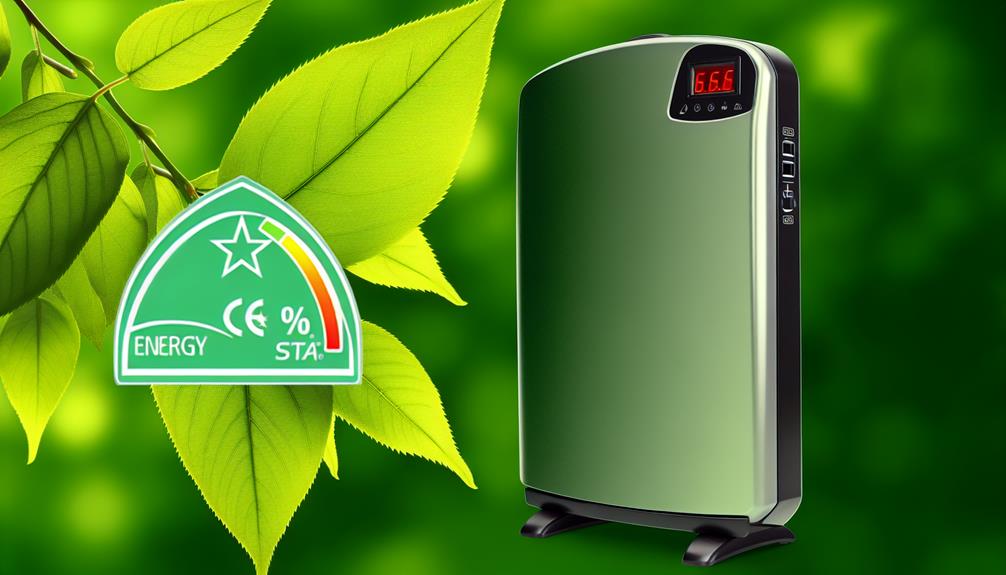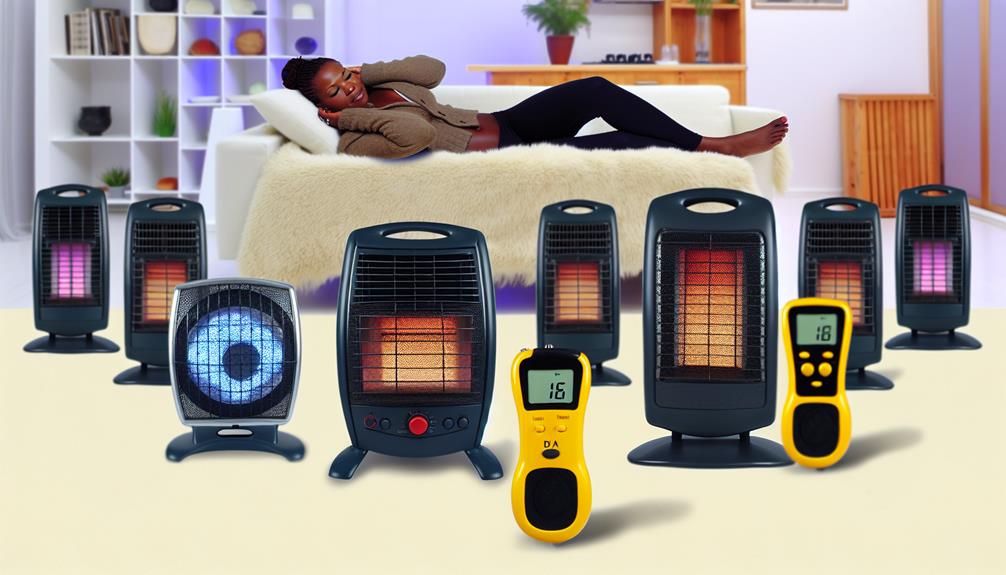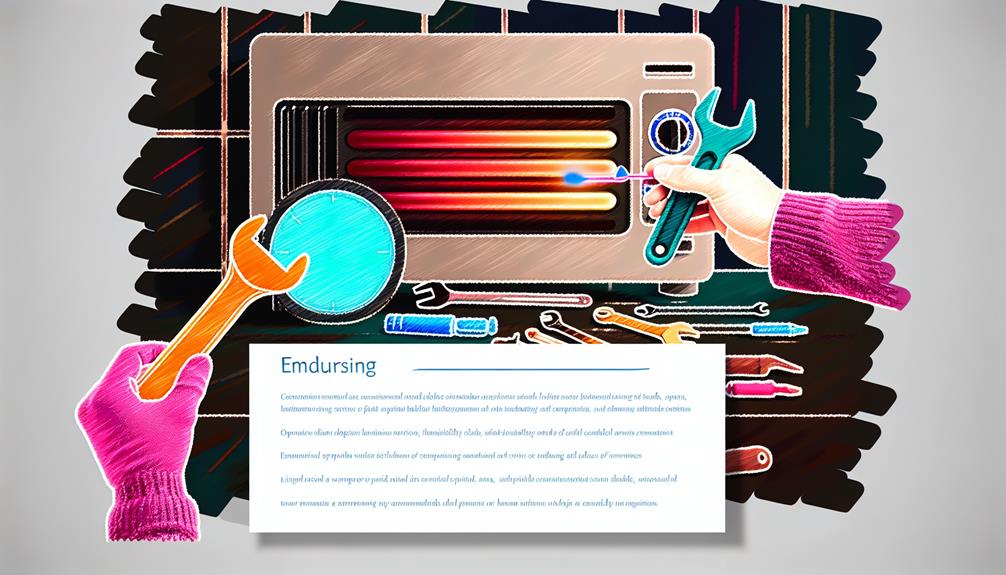Just as a seasoned navigator selects the right compass to chart a course, you must choose the appropriate portable heater to steer through the chilly months with ease. You're aware that a myriad of options awaits, from ceramic and infrared to oil-filled and electric. Yet, the question looms: which one will guide you to the warm haven of comfort without sinking your energy budget? As you contemplate the square footage needing warmth and your personal preferences, remember that safety features and energy efficiency are as crucial as the heater's capacity to banish the cold. In the following guide, you'll uncover the key considerations that will lead you to the ideal portable heater—the one that not only fits your space but also aligns with your lifestyle. Let's embark on a journey to find that perfect balance of coziness and cost, ensuring you're well-equipped for the winter's frosty embrace.
Key Takeaways
- Calculate the square footage and BTUs required for your space
- Prioritize safety features like automatic shut-off and cool-touch exteriors
- Look for high energy ratings and compare wattage among models for energy efficiency
- Consider additional features like thermostat control, noise level, portability, and maintenance requirements
Assessing Your Space
Before selecting a portable heater, you'll need to calculate the BTUs and required wattage by assessing the temperature increase and the volume of your space. Begin by determining the square footage of the area you wish to heat. Multiply the length by the width of the room to obtain this figure. Next, consider the types of space heaters available, such as convection space heaters, which distribute heat evenly throughout the room, or radiant heaters, which provide direct warmth to objects and people in their path.
For an accurate heating capacity, calculate the difference between the desired temperature and the current room temperature. This will give you the temperature increase needed. The volume of the space, alongside this temperature rise, is crucial in determining the BTUs (British Thermal Units) required for your space heater. Portable heaters vary in heating technologies, so choose one that aligns with your needs, be it for primary heating source or supplemental heating.
Always prioritize heater safety. Look for models with overheat protection and a tip-over switch to prevent accidents. Lastly, be mindful of the power consumption. Match your chosen heater's wattage and BTU rating with the cost analysis based on your local electric power provider's kilowatt/hour rate to gauge the operational cost.
Heater Types Explained
Understanding the different types of portable heaters is crucial to selecting the right one for your needs, as each variety offers distinct heating advantages and applications. Space heaters available on the market come in several styles and technologies, each designed for specific situations. Here's what you need to know about the most common types:
- Convection Heaters: These heaters use convection to quietly warm an entire room by circulating hot air. Convection space heaters are ideal for maintaining steady heat over extended periods.
- Radiant/Infrared Heaters: If you're looking for instant warmth, these heaters provide direct heat by warming objects and people rather than the air. They're perfect for spot heating and smaller spaces.
- Fan-forced Heaters: These units push air over a heated element, distributing warmth quickly throughout the room. They're versatile and work well in many settings.
When considering which type of space heater to buy, think beyond just the initial blast of warmth. For example, oil-filled radiators, though slower to heat up, offer sturdy construction and residual heat, making them cost-effective for long-term use. Meanwhile, wall heaters are a more permanent solution for consistently under-heated areas. Your Space Heater Buying Guide should reflect not just the heater's capability, but also how its operation aligns with your living space and heating needs.
Energy Efficiency

You should consider heater energy ratings when selecting a portable heater, as they determine the unit's energy usage and efficiency. By comparing wattage among models, you'll ensure you're choosing a heater that uses energy effectively without compromising on warmth. To optimize usage costs, select the lowest wattage heater that still satisfies your heating requirements.
Heater Energy Ratings
How efficiently does your portable heater convert energy into heat? Look for models with high energy ratings to ensure maximum energy efficiency and lower operating costs. When you're choosing a space heater, understanding its energy performance is crucial for supplemental heating without the hefty bills.
- Wattage and Square Footage: The lower the wattage required to heat a square foot, the more energy efficient the heater is.
- British Thermal Units (BTUs): Heaters with higher BTUs deliver more heating power, but ensure it's proportionate to the space to avoid waste.
- Convection Space Heaters: These heaters work by warming the air rather than objects, typically using less electricity and offering better energy efficiency.
Optimizing Usage Costs
To optimize usage costs and enhance energy efficiency, select a space heater with the appropriate wattage for your room size, considering the local kilowatt/hour rate for precise operating cost estimation. Using a space heater with too many watts of heating power for a small room is inefficient, while one with insufficient heating power will struggle in larger spaces, failing to provide economical and convenient warmth. Space heaters can make targeted heating possible, allowing you to lower the reliance on central heating for unused areas, which can help you save energy. To determine the cost per hour of operation, multiply the heater's wattage by the local rate and divide by 1,000. Remember, heaters and large energy demands should be balanced with safety features to prevent accidents.
Safety Features
As you consider your portable heater options, prioritize models with an automatic shut-off function, which powers down the unit if it tips over or overheats. Look for heaters that incorporate an overheat protection mechanism, a critical feature that interrupts the power to prevent potential fire risks. Ensure the unit you select has a cool-touch exterior design, providing an extra layer of safety, especially in homes with children or pets.
Automatic Shut-Off Function
When selecting a portable heater, consider models with an automatic shut-off function to significantly lower the risks of overheating and potential fires. This crucial safety feature is a must-have when buying a space heater.
Here's why the automatic shut-off function is key:
- Peace of Mind: You won't fret about forgetting to turn the heater off—it's got your back.
- Extra Protection: In case of a tip-over, your heater would cut the power instantly, preventing accidents.
- Safety for All: Ideal around curious kids and pets, it ensures a safer environment.
Electric space heaters use different types of technology, but whether you're considering convection heaters or others, the automatic shut-off function should be non-negotiable. Always check for safety certifications like CSA or UL, which confirm the heating element within your chosen device meets stringent safety standards.
Overheat Protection Mechanism
Ensure your portable heater's safety with an overheat protection mechanism, a feature that automatically turns the device off if internal temperatures exceed safe limits. Heaters are typically used for supplemental heating, and it's essential to choose one with this mechanism to avoid the dangers associated with overheating. This technical safeguard is designed to respond when the heating element becomes too hot, indicative of a potential fire hazard.
When heating a whole room or simply using the heater to keep you warm in a smaller space, the overheat protection mechanism is pivotal. It ensures that heating using one space heater remains safe and efficient. By relying on natural convection, advanced models integrate these safety features seamlessly, allowing you to enjoy the warmth without worrying about safety risks.
Cool-Touch Exterior Design
Selecting a portable heater with a cool-touch exterior is crucial for preventing burns and enhancing safety, especially in homes with active children or pets. When you choose a space heater to supplement your primary heating, make sure it includes a cool-touch exterior design. This feature ensures that, despite the heating element working to keep you warm, the outer surface remains safe to touch.
Consider these key points:
- Safety for Loved Ones: A cool-touch exterior minimizes the risk of accidental burns, protecting everyone in the room.
- Ease of Handling: You can safely move the heater even while it's operating, thanks to this design.
- Versatility in Placement: With a variety of sizes available, heaters with a cool-touch exterior and an efficient blower fan won't damage surfaces, giving you more options to stay warm.
Thermostat and Control
Understanding the thermostat and control features on a portable heater allows you to tailor the temperature to your exact comfort level while optimizing energy usage. An adjustable thermostat provides precise temperature control, ensuring your space remains at the desired warmth. With multiple heating settings, you can easily adjust the heat output to match your comfort needs.
The programmable timer is an energy-saving feature that enables you to set heating schedules, reducing the need to operate the heater continuously. This not only conserves energy but also can help lower your utility bills. A digital display often accompanies these controls, offering a user-friendly interface that simplifies setting adjustments.
Some models include a remote control, which brings convenience to your fingertips, allowing you to modify settings without having to physically interact with the heater. This is particularly helpful if the heater is placed in hard-to-reach areas.
Here's a quick reference table to evoke the comfort and control you'll gain:
| Feature | Benefit | Emotion Evoked |
|---|---|---|
| Programmable Timer | Set & forget heating schedules | Peace of Mind |
| Remote Control | Adjust settings from anywhere | Ultimate Convenience |
| Digital Display | Easy-to-read settings and adjustments | Clarity and Confidence |
Investing in a heater with robust thermostat and control features ensures precision heating and a cozy, energy-efficient home.
Noise Level Considerations

While adjusting your heater's settings to achieve the perfect temperature, you'll also want to consider the noise level, as a quiet heater enhances your comfort without intruding on your daily life. Space heaters come in a variety of types, each with its own noise level considerations. Buying a model that operates quietly can make a big difference, especially in a room where you work or relax.
Here are three key points to keep in mind:
- Decibel Rating: Look at the product specifications for the decibel rating. A lower decibel rating usually means quieter operation, ensuring your activities or conversations aren't disrupted.
- Noise Reduction Features: Some space heaters are designed with noise reduction in mind. These models work well in environments where silence is golden, like home offices or bedrooms.
- Heater Type: Convection or radiant heaters typically operate more quietly compared to fan-forced heaters, as they don't rely on a fan to distribute heat. The heating element in these heaters is designed to work efficiently without the need for much noise.
When shopping for a space heater, always consider the noise level to maintain a peaceful atmosphere in your living space.
Portability and Design
When choosing a portable heater, prioritize models with ergonomic features like carrying handles and wheels to ensure effortless mobility and convenient placement in any room. In this Industrial Heater Buying Guide, it's crucial to consider the size of the space you're looking to heat. For a smaller space, a unit that emits radiant heat may suffice, while larger areas might require a heater with a fan to distribute heated air more evenly.
As you evaluate portability and design, never use an extension cord as it can pose a safety risk. Instead, check the length of the heater's power cord and its placement to ensure it reaches the outlet without stretching or causing a trip hazard. The Right Size heater not only refers to heating capacity but also to physical dimensions, so it won't dominate your living area or clash with your decor.
Opt for a portable heater with adjustable settings for a customized experience. Look for safety features such as cool-to-the-touch exteriors and tip-over protection, which are particularly important for easy transportation. Remember, the things to consider are not only about aesthetics but also about functionality and safety.
Maintenance and Durability

As you consider the portability and design features that suit your needs, bear in mind that the longevity and efficiency of your portable heater also hinge on regular maintenance and proper care. When it comes to maintenance and durability in the realm of space heater and industrial heater buying, there are critical factors you should not overlook:
- Heating Elements: The number of heating elements can impact how evenly and efficiently your heater warms a room. Infrared heaters, for example, have elements that directly heat objects rather than the air, which can mean fewer maintenance issues over time.
- Oil-Filled Units: Models filled with diathermic oil are prized for their ability to retain their heat for extended periods. This feature means less strain on the heating mechanism and often a longer lifespan for the unit.
- Cords and Connections: A frayed power cord is not just a safety hazard; it's a sign of neglect. Regularly inspecting and carefully handling the cord, as well as any connections, is crucial for safe operation and the preservation of your heater.
Remember that heaters with bonus features, such as programmable timers or remote controls, may require additional care to ensure these features continue to function properly. Adhering to a meticulous maintenance routine is the key to extending the life of your portable heater.
Frequently Asked Questions
How Do I Choose a Portable Space Heater?
To choose a portable space heater, you'll consider heater safety, like tip-over protection, and energy efficiency to keep bills low. Pick a heater size appropriate for your space, and check for thermostat features for better temperature control. Review noise levels for comfort, and mobility aspects for portability. Opt for eco-friendly options, and don't ignore maintenance tips to extend heater lifespan. Always ensure it meets your specific heating needs.
What Is the Most Effective Type of Portable Heater?
Imagine a cozy haven on a frosty day; the most effective portable heater turns this vision into reality. You'll want one that balances energy efficiency with rapid heating speed, while fitting your climate's demands. Seek out models with robust safety features, low noise levels, and minimal maintenance needs. Consider portability, design aesthetics, and ensure it's wallet-friendly by comparing prices and user reviews. Your choice should be a fusion of functionality and comfort.
How Big of a Room Will 1500 Watts Heat?
You're looking at a 1500-watt heater's heating capacity—it'll generally cover a room of about 150 square feet. But remember, energy efficiency, insulation impact, and your climate will affect performance. Positioning the unit for optimal temperature maintenance and considering safety features are key. The heating speed and power source also matter, especially in different usage scenarios. Always size your heater to ensure it meets your specific needs for space heating.
Which Heater Is Better Oil or Convection?
You're deciding between oil and convection heaters, right? For even heat distribution and energy efficiency, oil-filled models excel. They're quieter, too, with superior safety features. However, they often have a higher initial cost and aren't as portable. Convection heaters, on the other hand, offer quicker heating and are easier to maintain, but they can be noisier. Consider your room's size and heating needs alongside heater lifespan and environmental impact before purchasing.
